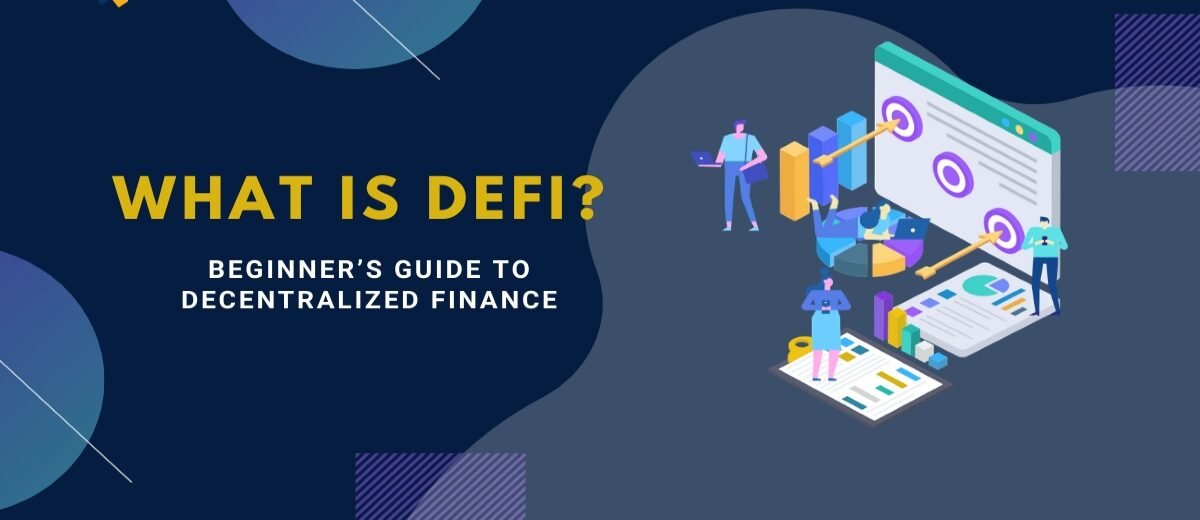Decentralized Finance, or DeFi, is a hot topic in the crypto world, promising a new way to borrow, lend, and invest without banks. But what exactly is it, and why should you care? DeFi uses blockchain technology to create financial services that are open to anyone with an internet connection. This beginner-friendly guide explains DeFi in plain English, how it works, and what it means for you in 2025. Let’s get started!

What is DeFi?
DeFi stands for Decentralized Finance, a system of financial tools and services built on blockchain technology, like Ethereum. Unlike traditional finance, which relies on banks and brokers, DeFi lets people access loans, savings, or trading directly through apps, without middlemen.
Key Idea: DeFi is like a digital bank run by code, open 24/7, where anyone can participate using a crypto wallet.
Why It Matters: DeFi cuts out fees and barriers, making finance accessible to millions who lack bank accounts.
How Does DeFi Differ from Traditional Finance?
To understand DeFi, let’s compare it to the financial system you know.
1. Traditional Finance
Banks, credit unions, and brokers control traditional finance. They decide who gets loans, charge fees, and store your money.
Examples:
- Getting a loan requires a credit check and paperwork.
- Bank accounts have fees and limited hours.
Downsides: High fees, slow processes, and exclusion of people without access to banks.
2. DeFi
DeFi runs on blockchains, using smart contracts (self-executing code) to handle transactions automatically. No bank or ID is needed—just a crypto wallet.
Examples:
- Borrow $100 in crypto instantly via a DeFi app.
- Earn interest by lending your crypto to others.
Benefits: Fast, cheap, and open to anyone with internet.

Key Features of DeFi
DeFi is built on unique technologies and principles. Here’s what makes it stand out in 2025.
1. Decentralization
DeFi apps (called DApps) run on blockchains, not company servers, so no single entity controls them.
Example: A DeFi lending app like Aave operates on Ethereum, managed by code, not a CEO.
Benefit: No bank can freeze your account or deny access.
2. Smart Contracts
Smart contracts are automated agreements that execute when conditions are met, like a digital vending machine.
Example: You deposit $50 in crypto to a DeFi app, and a smart contract pays you 5% interest monthly.
Tip: Learn about smart contracts on CoinDesk.
3. Accessibility
Anyone with a smartphone and crypto can use DeFi, no ID or bank account required.
Example: A farmer in a remote area can borrow crypto to buy seeds using a DeFi app.
Impact: DeFi serves the 1.4 billion unbanked people worldwide.
4. Transparency
DeFi transactions are recorded on public blockchains, so anyone can verify them.
Example: You can check a DeFi app’s lending history on Etherscan to ensure it’s legit.
Benefit: Builds trust without relying on a company.

5. Variety of Services
DeFi offers many financial tools, like lending, borrowing, trading, and earning interest, all without banks.
Examples:
- Lend crypto on Compound to earn 5–10% interest.
- Trade tokens on Uniswap without a broker.
Why is DeFi Popular in 2025?
DeFi has exploded because it solves real problems and opens new opportunities. Here’s why it’s a big deal.
1. Financial Freedom
DeFi lets you control your money without banks or governments, appealing to those seeking independence.
Example: You can lend crypto globally on Aave, earning interest banks can’t match.
Benefit: More control and higher returns.
2. High Returns
DeFi offers better interest rates than traditional savings accounts, often 5–20% annually.
Example: Depositing $100 in a DeFi savings app could earn $10–$20 a year, vs. $0.50 in a bank.
Warning: Higher returns come with higher risks.
3. Innovation
DeFi creates new financial tools, like decentralized exchanges (DEXs) and yield farming, not possible in traditional finance.
Example: Swap Bitcoin for Ethereum on Uniswap in seconds, no broker needed.
Tip: Explore DeFi innovations on Cointelegraph.
4. Global Access
DeFi is borderless, helping people in developing countries access financial services.
Example: A small business in Africa can borrow crypto to grow, without a local bank.
Risks of DeFi for Beginners
DeFi is powerful but not risk-free. Here’s what to watch out for in 2025:
- Smart Contract Bugs: Code errors can lead to losses, as seen in 2023 hacks.
- Scams: Fake DeFi apps can steal your crypto.
- Volatility: Crypto prices can crash, affecting your DeFi investments.
- High Fees: Ethereum’s “gas fees” can cost $10–$100 per transaction.
- Regulation: Governments may crack down on DeFi, impacting access.
Tip: Use low-fee blockchains like Polygon to reduce costs.
How to Start with DeFi Safely
Excited about DeFi? Follow these beginner-friendly steps to explore it safely in 2025.
1. Set Up a Crypto Wallet
A wallet like MetaMask connects you to DeFi apps and stores your crypto.
How to Do It:
- Install MetaMask as a browser extension or app.
- Create a wallet and save your seed phrase offline on paper.
- Buy $10–$50 of Ethereum via Coinbase.
Warning: Never share your seed phrase to avoid hacks.

2. Explore Trusted DeFi Platforms
Start with reputable DeFi apps to lend, borrow, or trade crypto.
Recommended Platforms:
- Uniswap: Swap cryptocurrencies easily.
- Aave: Lend or borrow crypto with high interest.
- Compound: Earn interest by lending crypto.
How to Start: Connect your MetaMask wallet to Uniswap and swap $10 of Ethereum for another token.
3. Start Small
DeFi is risky, so begin with small amounts to learn without big losses.
How to Do It:
- Lend $10 on Compound to earn interest.
- Swap $5 on Uniswap to understand trading.
- Only use money you can afford to lose.
Example: Lending $10 on Aave teaches you DeFi without risking much.
4. Research Before Using
Not all DeFi apps are safe. Research to avoid scams or buggy platforms.
How to Do It:
- Check the app’s history and audits on CoinGecko.
- Read community feedback on Reddit’s r/defi.
- Stick to established platforms like Aave.
Example: Aave’s long track record makes it safer than a new, untested app.
5. Secure Your DeFi Assets
Protect your crypto from hacks or scams with strong security.
How to Do It:
- Enable 2FA on exchanges like Coinbase with Google Authenticator.
- Use a hardware wallet like Ledger for large amounts.
- Verify URLs (e.g., “uniswap.org,” not “uniswapp.org”).
- Avoid clicking links from unknown X posts.
Example: In 2024, DeFi scams stole millions. A Ledger wallet keeps your funds safe.
What to Watch Out For
DeFi offers opportunities but requires caution. Stay alert for:
- Fake Apps: Phishing sites mimic real DeFi platforms.
- Price Crashes: Crypto volatility can wipe out gains.
- Technical Risks: Bugs in smart contracts can lead to losses.
Tip: Start with small transactions and trusted platforms to minimize risks.
Conclusion
DeFi is transforming finance by offering open, decentralized tools for lending, borrowing, and trading, all without banks. While it’s exciting, it’s also risky, so start small with a MetaMask wallet, explore platforms like Uniswap or Aave, and secure your assets with a Ledger. Stay informed via Cointelegraph and research on CoinDesk. With these steps, you’ll explore DeFi’s potential safely in 2025!




